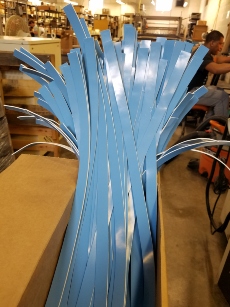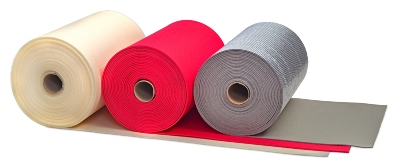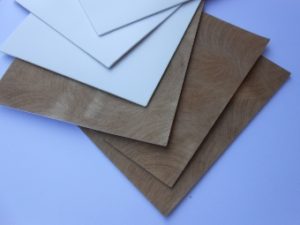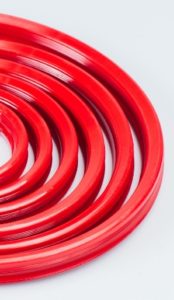Home » Technical » Additional Materials » Plastic
Plastic
Plastic is a polymer material that exhibits structural integrity under a load, made from polymers of carbon atoms surrounded by hydrogen, oxygen, nitrogen, and sulfur.
Plastic Materials for Gaskets, Seals and Other Components
 Originally, plastic resins were made from vegetable matter including cellulose from plants and trees, furfural from oat hulls, seed oils, and various starch derivatives. Synthetic versions were developed to replace scarce natural substances such as tortoise shell. John Wesley Hyatt is credited with developing the first synthetic polymer in 1869, apparently motivated by a New York company’s $10,000 incentive to create a substitute for ivory. Today most plastics are made using hydrocarbons in petrochemicals such as coal, crude oil and natural gas as the base, or other polymers such as polyethylene or nylon.
Originally, plastic resins were made from vegetable matter including cellulose from plants and trees, furfural from oat hulls, seed oils, and various starch derivatives. Synthetic versions were developed to replace scarce natural substances such as tortoise shell. John Wesley Hyatt is credited with developing the first synthetic polymer in 1869, apparently motivated by a New York company’s $10,000 incentive to create a substitute for ivory. Today most plastics are made using hydrocarbons in petrochemicals such as coal, crude oil and natural gas as the base, or other polymers such as polyethylene or nylon.

A broad category of polymer base chemistries can be mixed with a variety of additives to enhance the chemical, mechanical or physical properties of plastics: antioxidants, antistatics, antimicrobials, colorants, flame retardants, foaming agents, lubricants, plasticizers, and stablilizers. They can also include elastomers, fibers, and fillers, or added surface coatings, to produce an unlimited array of plastics that offer thousands of unique properties.
Similar to elastomers, plastics are usually categorized as either thermoplastic or thermoset. Thermoplastics can be remelted back into liquid form while thermoset plastics permanently remain in a solid state after the curing process.
Thermoplastics
Thermoplastics are made up of polymers in a linear chain with molecules joined by weak bonds. This allows the material to become soft and flexible when heated and then harden when cooled, a process that can be repeated indefinitely. They have low melting points, allowing them to continuously withstand the reheating/remolding/cooling processes, and are the most common type of plastics.
General industrial thermoplastics typically have good resistance to chemicals, electrical current, heat, impact, moisture and a variety of other contaminants. They are lightweight and can be melted down for recycling.
Common types of industrial thermoplastics include:
- acrylic (PMMA)
- acrylonitrile butadiene styrene (ABS)
- polyamide, or nylon (PA)
 polylactic acid (PLA)
polylactic acid (PLA)- polycarbonate (PC)
- polyethylene (PE)
- polypropylene (PP)
- polyether ether ketone (PEEK)
- polytetrafloroethylene (PTFE)
- polyvinyl chloride (PVC)
Polyethylene, discovered by accident in the early twentieth century, is the most commonly used thermoplastic for fabricated components. It is economical, has superior chemical resistance, electrical properties, and good impact resistance, with a low coefficient of friction, and is available in low, medium, high and ultra-high densities.
A few decades later, polypropylene was developed by Italian scientists. It has a high melting point, resists stress even when flexed, and is non-reactive to acids, bases, detergents and water. PVC was also among the earliest plastics synthesized, made from a combination of salt and oil or gas, and can be either flexible or rigid. Today, these three make up the majority of plastics manufactured around the world.
 Another popular plastic is the fluoropolymer group. These plastics are useful for their excellent non-stick properties, making them effective in numerous aerospace, architectural, commercial, communications, electronics, industrial, and life sciences applications. PTFE (and particularly the brand Teflon®) is the most well-known fluoropolymer.
Another popular plastic is the fluoropolymer group. These plastics are useful for their excellent non-stick properties, making them effective in numerous aerospace, architectural, commercial, communications, electronics, industrial, and life sciences applications. PTFE (and particularly the brand Teflon®) is the most well-known fluoropolymer.
Thermosets
Thermosets are formulated from much larger polymer chains than thermoplastics, with strong molecular bonds in two- or three-dimensional networks. Their distinction is that they are cured into a permanent shape. Thermoset chemical bonds have a higher energy and can tolerate higher temperatures than thermoplastics so that, once cured, they cannot be melted, remolded or reformed. Excessive heat will cause thermal degradation.
The advantage of thermosets is their remarkable durability and strength. However, they are less common, making up less than 10% of all plastics manufactured.
Examples of thermosets include:
- epoxide (EP)
- phenol-formaldehyde (PF)
- polyurethane (PUR)
- unsaturated polyester resins (UP)
 Polyurethanes are a durable, flexible and resilient group of plastics. There are numerous varieties of polyurethanes, each of which is distinct in appearance and feel. Originally developed as a substitute for rubber, which was in short supply at the beginning of World War II, flexible polyurethane foams became more commercially available in the late 1950s.
Polyurethanes are a durable, flexible and resilient group of plastics. There are numerous varieties of polyurethanes, each of which is distinct in appearance and feel. Originally developed as a substitute for rubber, which was in short supply at the beginning of World War II, flexible polyurethane foams became more commercially available in the late 1950s.
Polyurethane resists abrasion, acids, heat, oil, solvents and harsh environmental elements. It has good abrasion resistance, compression strength, impact resistance, hardness, noise abatement, tensile and tear strength, making it an effective long-term solution for high load and high stress applications.

